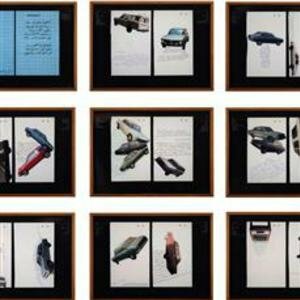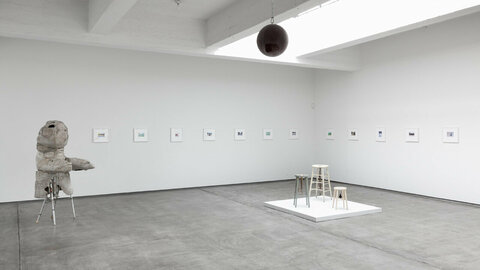


Last updated on Thu 19 March, 2015


Jonathan Borofsky, Bruce Conner, Sam Durant, Matias Faldbakken, Emily Feather, Liz Glynn, Robert Grosvenor, Douglas Huebler, Christian Marclay, Justin Matherly, Claes Oldenburg & Coosje van Bruggen, Walid Raad, Rudolf Stingel, Suha Traboulsi, Kelley Walker
MARCH 19 – APRIL 25, 2015
521 W 21ST STREET
NEW YORK—The Paula Cooper Gallery is pleased to present a group show of works by fourteen artists including Jonathan Borofsky, Sam Durant, Matias Faldbakken, Emily Feather, Liz Glynn, Robert Grosvenor, Douglas Huebler, Christian Marclay, Justin Matherly, Claes Oldenburg and Coosje van Bruggen, Rudolf Stingel, Suha Traboulsi and Kelley Walker.
The title “Dissolving Margins” is taken from Elena Ferrante’s 2012 novel, My Brilliant Friend, and describes the character Lila’s recurring existential episodes. During these distressed perceptual states, Lila has “the impression that something absolutely material, which had been present around her and around everyone and everything forever, but imperceptible, was breaking down the outlines of persons and things and revealing itself” (p.89-90). The works included in the show are bound by this disruptive experience; each confronts preconceived ideas and normative modes. They deceive and beset, or playfully satirize—in sum they form an unsettling conspiracy.
Drawing from commodification and mass production, many of these works reconstitute objects, ubiquitous to contemporary culture, in incongruent yet familiar materials. For his work, Circle in circle, Kelley Walker replaces a disco ball’s mirrored facets with molded chocolate. Its organic surface degrades with age, producing a muted chalky bloom, rather than the eternal glitter of reflected light. The object’s unexpected and cheeky materiality exploits inherent codes to reveal the propaganda of commercial goods—a practice which Claes Oldenburg and Coosje van Bruggen pioneered in their mixed media works of art. Drawn in pastel, the duo’s anthropomorphized shuttlecock performs a feat of superhuman acrobatics. The absurdist scene irreverently animates the inanimate object, as do the reconfigured stools in Christian Marclay’s Wind Section Series.
Several of the artists deconstruct the process of art-making itself to reveal creative artifice. Cast around disassembled ambulatory equipment, Justin Matherly’s corroded concrete sculptures precariously balance atop their protruding aluminum appendages. Excerpted in part from Friedrich Nietzsche’s books Thus Spoke Zarathustra and Ecce Homo, their titles reference themes of nihilism and its antithesis, supreme affirmation. Matias Faldbakken similarly dismantles fabrication to elude semantic specificity. In replicating cardboard pizza boxes with poured cement, his work blurs the distinction between monumental and banal. The monolithic concrete slabs suggest an enduring strength in contrast to the perishable food containers. Yet the twisting tower fails to resolve architectural stability as the two densities clash in turbulent disharmony. This equivocating thread weaves into Rudolf Stingel’s aluminum carpet as well; his compact metalized textile mines the tension between sculpture, painting and decorative design.
Employing misattribution and duplicitous historiography, other works contest the inviolability of authorship. Emily Feather’s intricate inkblots harbor her enigmatic relationship as an apprentice to Bruce Conner, while Douglas Huebler’s work includes a subversive reproduction of a historical masterpiece. Narrative boundaries dissolve further in the art of Suha Traboulsi, a Palestinian artist who greatly influenced Walid Raad. These vibrantly colored works, full of restrained geometry and austere lines, eerily foreshadow the visual trends of the 1960s. Beyond any other successor, Walid Raad draws on Traboulsi’s prophetic style. They comparably manipulate ink and paper to flatten and compress the picture plane, forming a continuous aesthetic dialogue.
The recent works by Liz Glynn and Sam Durant find their inspiration in literature. Glynn’s bronze patinaed still-life pays homage to Honoré de Balzac’s The Red Inn, whose infamous precept looms throughout her artistic practice: “behind every great fortune lies a great crime.” Durant titles his work with the concluding line of Caribbean Surrealist Suzanne Césaire’s 1945 essay, The Great Camouflage. Jonathan Borofsky’s Giraffe/Escalator Video Animation Installation illustrates a merging of minimal and organic imagery. Finally a selection of four photographs by Robert Grosvenor round out the exhibition, exemplifying this artist’s idiosyncratic look at place and sculptural form.
The show will be on view from March 19 – April 18, 2015 at 521 West 21st Street.
For more information, please contact the gallery: (212) 255-1105 or [email protected]
Artist Pages: Bruce Conner, Sam Durant, Matias Faldbakken, Liz Glynn, Robert Grosvenor, Douglas Huebler, Christian Marclay, Justin Matherly, Claes Oldenburg & Coosje van Bruggen, Walid Raad, Rudolf Stingel, Kelley Walker
Join us in our endless discovery of modern and contemporary Arab art